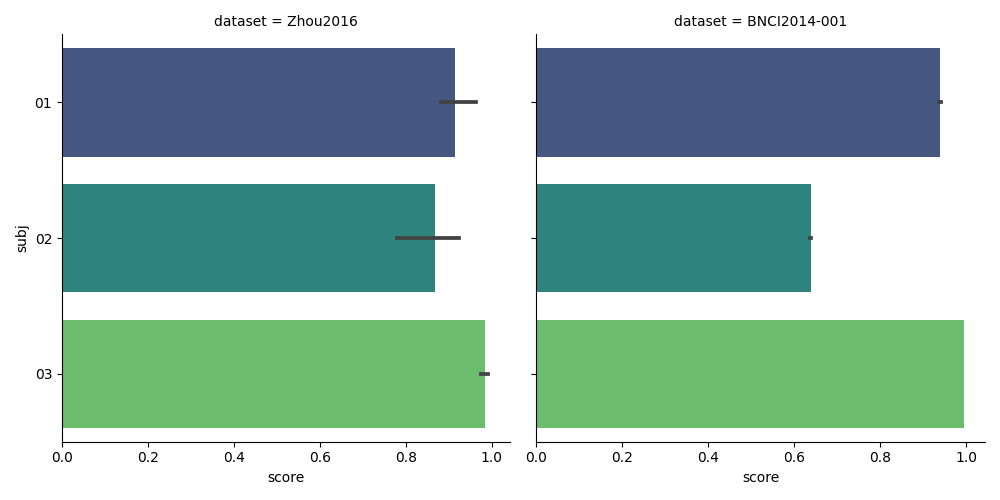Note
Go to the end to download the full example code.
Tutorial 2: Using multiple datasets#
We extend the previous example to a case where we want to analyze the score of a classifier with three different MI datasets instead of just one. As before, we begin by importing all relevant libraries.
# Authors: Pedro L. C. Rodrigues, Sylvain Chevallier
#
# https://github.com/plcrodrigues/Workshop-MOABB-BCI-Graz-2019
import warnings
import matplotlib.pyplot as plt
import mne
import seaborn as sns
from mne.decoding import CSP
from sklearn.discriminant_analysis import LinearDiscriminantAnalysis as LDA
from sklearn.pipeline import make_pipeline
import moabb
from moabb.datasets import BNCI2014_001, Zhou2016
from moabb.evaluations import WithinSessionEvaluation
from moabb.paradigms import LeftRightImagery
moabb.set_log_level("info")
mne.set_log_level("CRITICAL")
warnings.filterwarnings("ignore")
Initializing Datasets#
We instantiate the two different datasets that follow the MI paradigm (with left-hand/right-hand classes) but were recorded with different number of electrodes, different number of trials, etc.
datasets = [Zhou2016(), BNCI2014_001()]
subj = [1, 2, 3]
for d in datasets:
d.subject_list = subj
The following lines go exactly as in the previous example, where we end up obtaining a pandas dataframe containing the results of the evaluation. We could set overwrite to False to cache the results, avoiding to restart all the evaluation from scratch if a problem occurs.
paradigm = LeftRightImagery()
evaluation = WithinSessionEvaluation(
paradigm=paradigm, datasets=datasets, overwrite=False
)
pipeline = make_pipeline(CSP(n_components=8), LDA())
results = evaluation.process({"csp+lda": pipeline})
Zhou2016-WithinSession: 0%| | 0/3 [00:00<?, ?it/s]
Zhou2016-WithinSession: 33%|███▎ | 1/3 [01:04<02:08, 64.12s/it]
Zhou2016-WithinSession: 67%|██████▋ | 2/3 [01:29<00:41, 41.36s/it]
Zhou2016-WithinSession: 100%|██████████| 3/3 [01:55<00:00, 34.51s/it]
Zhou2016-WithinSession: 100%|██████████| 3/3 [01:55<00:00, 38.64s/it]
BNCI2014-001-WithinSession: 0%| | 0/3 [00:00<?, ?it/s]
BNCI2014-001-WithinSession: 33%|███▎ | 1/3 [00:00<00:00, 6.69it/s]
BNCI2014-001-WithinSession: 67%|██████▋ | 2/3 [00:00<00:00, 7.86it/s]
BNCI2014-001-WithinSession: 100%|██████████| 3/3 [00:00<00:00, 8.30it/s]
BNCI2014-001-WithinSession: 100%|██████████| 3/3 [00:00<00:00, 8.03it/s]
Plotting Results#
We plot the results using the seaborn library. Note how easy it is to plot the results from the three datasets with just one line.
results["subj"] = [str(resi).zfill(2) for resi in results["subject"]]
g = sns.catplot(
kind="bar",
x="score",
y="subj",
col="dataset",
data=results,
orient="h",
palette="viridis",
)
plt.show()

Total running time of the script: (1 minutes 58.275 seconds)
Estimated memory usage: 533 MB